The next-gen MacBook Pro with Retina Display Review
by Anand Lal Shimpi on June 23, 2012 4:14 AM EST- Posted in
- Mac
- Apple
- MacBook Pro
- Laptops
- Notebooks
Final Words
Apple has done an incredible job with the next-gen MacBook Pro. It brings a level of portability to the 15-inch chassis that we’ve never seen before from Apple, all while getting a good handle on some of the thermal and noise issues from last year’s model. If you’re like me and have to lug your 15-inch MBP around, the improvements in portability alone are worth the upgrade. But a lighter chassis is hardly all Apple is relying on to sell this system.
The internals are easily the best collection of parts Apple has ever assembled. Ivy Bridge and Kepler are natural fits, but shipping the machine with 8GB of memory by default is a much appreciated gesture especially considering its un-upgradeable nature. For the first time in Apple’s history of shipping NAND flash based storage in Macs, I actually have no complaints about the controller choice in the rMBP. Samsung’s PM830 (or the consumer, SSD 830, version) is what I’ve been recommending to Mac users for much of the past year. It’s still possible that you’ll end up with a non-Samsung controller, and I don’t yet know whether or not that’s a bad thing, but this is at least progress.
The connectivity story on the rMBP is near perfect. The pair of Thunderbolt ports allows extra flexibility as well as the ability to drive more bandwidth to external IO than any prior portable Mac. The Thunderbolt teething issues still remain unfortunately, but it looks like that’s going to require at least a partial act of Intel to rectify. USB 3.0 is a welcome addition to the Mac family. It took both Apple and Intel far too long to get to this point, but I’m glad it’s here.
All of this is really just wrapping however, as the real gift is the MacBook Pro’s first Retina Display. It’s easily the most beautiful display I’ve had the opportunity of using. Even more impressive to me than the iPad’s Retina Display, and enough to make me actually want to use the Mac as a portable when at home rather than tethered to an external panel. The added portability of the chassis likely contributes to that fact though.
The credit Apple deserves for the display extends beyond simply pushing LG to get a panel out on time and in large enough quantities. There’s a tremendous amount of software work that Apple put into making the Retina experience work under OS X. The OS and several key applications have been updated to properly support the MacBook Pro’s Retina Display, and things can only get better from here. Mountain Lion will improve performance and I would expect at least a few key app updates over the next year to bring increased Retina awareness.
There’s also the behind the scenes work Apple put in to make all of this happen. The pressure on the GPU vendors, as well as taking matters into its own hands with writing scaling and filtering routines to deliver a good experience are all noteworthy.
It’s because all of this that I’m doing something I’ve never done before in an Apple review. We rarely give out Editor’s Choice awards at AnandTech, and I’m quite possibly the stingiest purveyor of them. I feel that being overly generous with awards diminishes their value. In this case, all of the effort Apple has put into bringing a Retina Display to the MacBook Pro is deserving of one.
 I’m giving the MacBook Pro with Retina Display our bronze Editor’s Choice award. Making it the first Mac to ever receive one. It would have been a silver had the software story been even stronger (iWork, Mountain Lion, Office and Photoshop being ready at launch would have been a feat worth rewarding). And it would have been a gold had Apple been able to deliver all of that but without sacrificing end-user upgradability. Which brings me to my final point.
I’m giving the MacBook Pro with Retina Display our bronze Editor’s Choice award. Making it the first Mac to ever receive one. It would have been a silver had the software story been even stronger (iWork, Mountain Lion, Office and Photoshop being ready at launch would have been a feat worth rewarding). And it would have been a gold had Apple been able to deliver all of that but without sacrificing end-user upgradability. Which brings me to my final point.
I accept the fact that current mobile memory and storage form factors preclude the creation of the thinnest and lightest form factors. But I would like to see Apple push for the creation of industry standard storage and memory form factors that wouldn’t hinder the design of notebooks like the Retina Display equipped Macbook Pro. As Apple has already demonstrated that it has significant pull with component vendors, this should be possible. The motivation behind doing so is no different from the motivation driving the use of Retina Displays: for the betterment of the end user experience.
Sidebar: Impacting the Rest of the Industry
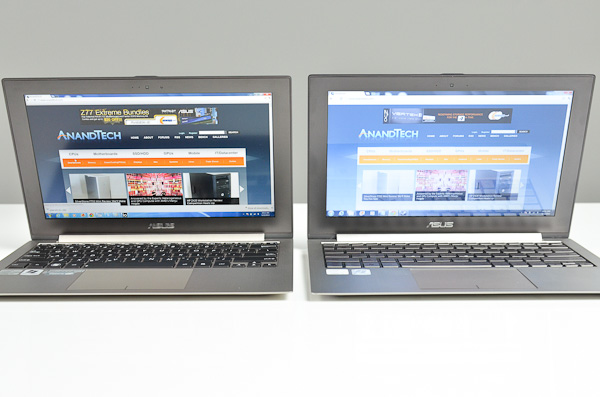
ASUS Zenbook Prime (left) vs. Zenbook (right)
Apple’s impact on the industry has already been felt. The threat of Apple bringing Retina Displays to its entire lineup forced ASUS’ hand and gave us 1080p IPS panels in the new Zenbook Primes. This will undoubtedly continue. In the early days Apple simply raised the bar for a focus on industrial design. Apple’s influence quickly expanded to touch everything from packaging to trackpads. We’re now seeing PC OEMs focus far more on experience than they ever have before. Apple isn’t the only one to thank for this, but the company is a significant factor.
The fact of the matter is the days of blaming a lack of innovation on cost or the inflexibility of one’s suppliers are over. In fact, those days are long gone. Today the MacBook Pro with Retina Display exists at a very high starting price, but make no mistake, it won’t remain there indefinitely. Apple introduced this model as the next-generation MacBook Pro because it truly is a preview of what’s to come. Maybe next year’s model won’t be any cheaper, but the one after that definitely will be. Apple has a healthy obsession with high quality displays and it will put its might behind panel suppliers until it can put forth a lineup of top to bottom Retina Displays. There’s no doubt in my mind that within the next 12 - 24 months Apple will introduce an external 4K Retina Display. Whether you love, hate or are indifferent about Apple and its products, its impact on the industry is tangible. PC OEMs now care about display quality and keyboard feel. They care about trackpads and design. There’s only one motivator in this industry stronger than Moore’s Law: experience, and the PC OEMs finally care about that too.
Apple’s success hasn’t been because it is a vertically integrated company. On the contrary, everything Apple has done Acer, Dell, HP, Intel, NVIDIA and Microsoft could have done together. Apple is successful because its competitors have all been selfishly focused on themselves rather than all coming together to build better computers. Based on my conversations with Intel and some of the OEMs at Computex earlier this month, the wake up call has been heard. Intel seems quite motivated to help its OEM partners do better. It is a bit troubling for the ecosystem that Microsoft is throwing its hat into the ring as a competitor - especially as it was Microsoft's inaction on the software side that really hurt the PC OEMs over the past several years.
For years we’ve been pushing OEMs to focus on better displays, and for years we were given cost and customers-don’t-care as excuses for why we don’t get them. That’s all starting to change.


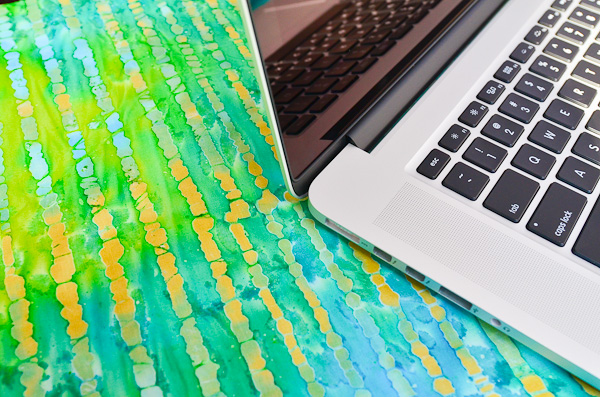
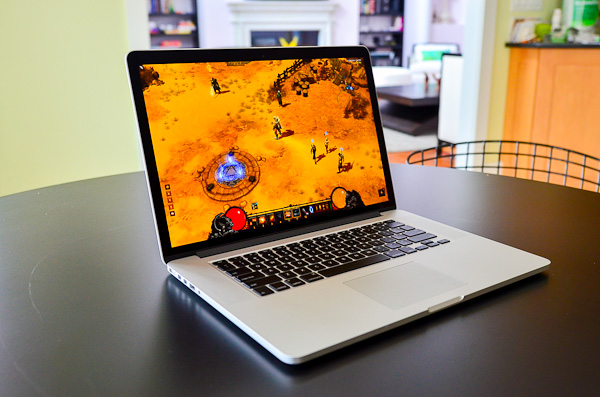
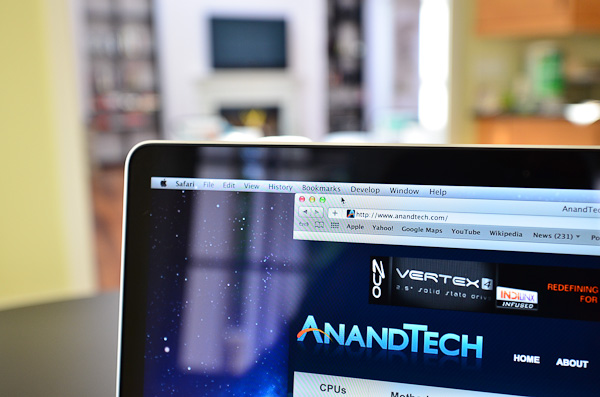
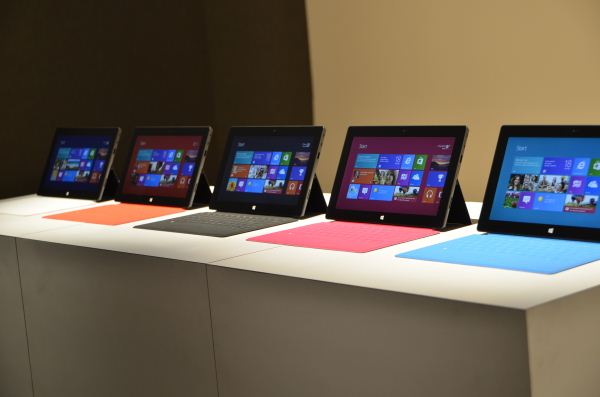








471 Comments
View All Comments
darkcrayon - Tuesday, June 26, 2012 - link
I hear you can work around that by not using that feature ;)Spunjji - Tuesday, June 26, 2012 - link
this is lost deep in the comments, so I doubt it will get any form of response. Nonetheless, while I feel this review has covered the ground incredibly well, there were some sever omissions that limit its usefulness.Where, for instance, are the comparisons to laptops that are not made by Apple? It's all well and good telling me that this laptop is cooler than its predecessor, but the trouble is that I didn't buy the 15" MBP because it turns into an unpleasantly hot and noisy beast as soon as you start gaming on it. Based on the surface temperatures you give, it sounds like this is no better with the new model *relative to non-Mac laptops* and yet I have no real way of knowing this for sure. I'd really appreciate that comparison - the same goes for battery life. In my case I currently use an Alienware M17x and would absolutely love to trade to something lighter with similar capabilities, but I need to know what the usability caveats will be.
I also feel that this site is asking us to take a lot on faith with regards to Thunderbolt. It's been a year and we can still only really attach storage to it outside of proprietary configurations, and even that doesn't work very well. We are also faced with the possibility that the first-gen tech will *never* work properly, yet it is still primarily mentioned as a good thing, with the rather horrible flaws pointed out deep within the bowls of a lengthy analysis.
flatform - Tuesday, June 26, 2012 - link
I am surprised not to see Anand commenting on the SEVERE problem that MOST users have with the Retina Displays -at least those mac users who are able to actually see a problem on their mac-. Advertising reasons maybe???Macbook Pro Retina -Plasma-TV-like(!!!!!)- Ghosting/Burn-in Issues
https://discussions.apple.com/thread/4034848?start...
IPad Retina issues: http://www.cultofmac.com/161495/new-ipads-retina-d...
Plus, the only reason for apple not to put gigabit is that the port did not fit in the new slimmer UPPER profile, not the case itself, it would had ruined their design lines, that is all!!!!! The 2012 Vaio Z is much slimmer but has a gigabit port, strangely implemented yet still there. Having worked for years with macs, we ALWAYS had the same problem, when you needed that adpter you had bought, it just wasn't -for any reason- there.... humiliating experience in front of clients...
having not normal SSD and especially no double slot configurable memory is probably just crap, 80% of laptops and desktops receive a hard drive and memory upgrade. just to shed off 100 Grams and 2mm of height?? 2009 Dell's Latitude Z600 was slimmer, 16inch displa, 2.0Kgs, yet had a normal hard drive and memory popped in.
Anand, with a 4 core/8 Thread Machine 16GB is BARELY enough TODAY, to work with Photoshop, Premiere, After FX and a RAW developer open, and still have free memory so that after fx can use all Threads. And That did not include one or 2 3D applications that a compositor would usually run. 16GB is the minimum, 32GB is the choice for the Video Professional. With so many programs switching to GPU processing, you should really be careful when commenting on the power of any machine with a dedicated graphic card.
For god's shake just wait and do not buy this crappy notebook. It is even more faulty than the first generation of 13inch Macbooks... wait at least 6 months for a proper revision, up to then Retina PC's will be available as well, with proper RETINA IPS displays with no burn-in issues and upgradeable parts.
darkcrayon - Tuesday, June 26, 2012 - link
I like how you mentioned the Vaio Z to bash the rMBP design, and then you went on to bash the rMBP for "limitations" that the Vaio Z also has (soldered RAM, though limited to 8GB, and more. Though off topic, your almost 3 month old iPad retina display problem is a nice touch, considering anyone with the problem could've gotten theres replaced for free. Please let us know which company is making millions of 260 ppi 10" screens with 100% perfect yields...flatform - Tuesday, June 26, 2012 - link
Comment on Vaio Z was just to point out stupid decisions who take into consideration only the looks of the machine, not direct comparison of the two machines, which are not comparable. Apple could have kept the same upper profile and diminish the lower bevel part. But it would not LOOK as thin. Let's see how professional Photographers -which i work with- will welcome the lack of FW800 and the need to echange 2-3 adapters to do one job, or the presence of only 2 USB's is a total failure when working in production environment. I am a professional industrial designer and compositor, believe me i would really like rMBP to serve me properly (i have been complaining about low-res screens since 2006) but it simply cannot. Replacing for free is the most logical thing to do and does not replace the evident problem. The iPAD is not of topic, it is a High PPI, same technology display which suffers from similar problems, just as the Macbook Display.My comment was that if Anandtech was serious about this review -respecting the readers that is- it SHOULD have mentioned -in a separate page with the fullest possible technical description- the problem in a clean and straightforward way, even if their sample did not have it (have they checked for it?)
When me moved from CRT's to TFT's (degrading our color reproduction, resolution and image quality) we did it because TFT;s had a hell less eyestrain, radiation, consumed less current and desk space. I cannot accepted that shedding off 150 grams (max) and 2mm of thickness from a WORKSTATION laptop is revolutionary and should force professionals to use adapters for the bluddy most used ports of their laptops, while depriving them from the most common upgrade in a notebook: memory and hard disk.
As for the last question, please let us know which company has developed the screen for apple and how many months later the same screen would be available in pc's as well.
Good thing Apple made the move, cause it has been FAR BEHIND in displays, (remember they where selling 1440x900 on 17" and 1280x800 on 15", then making it 1680x1050 and 1440x900 respectively, whereas a 1920x1200 15" screen was a common thing in mobile workstations) since they first brought a somewhat proper for graphic use display on their 2003 15" G4 Titanium. Workstation notebooks have IPS monitors for many years now.
robco - Tuesday, June 26, 2012 - link
Looking at the Googles, the news stories about the ghosting issues were posted today. Not something that likely would have been found before posting the review. This is a new display manufacturing process and there are going to be some mistakes. Never buy the first version, or at least the first production run, of any Apple product. This is one of the downsides to being an early adopter of almost any new technology. Apple tends to wait and collect data rather than acting rashly (see iPhone 4 fiasco). There isn't any data showing if this is a widespread problem, or only affecting a small percentage of units. But Apple will replace defective units.It took a little while, but third-party SSD upgrades are available for the MacBook Air. But on another note, would you expect *every* piece of equipment in your shop to be 100% user-upgradeable?
Everyone whined when Apple ditched floppies, serial, ADB and SCSI. There were adapters and people, well they adapted as well. I'm sure some will just buy a Thunderbolt dock (a couple are coming in a few months) and hook up all their peripherals and then connect them (as well as gigabit Ethernet) to the laptop with a single cable. Some folks may even be OK with trying desperately to live with only 16GB of non-upgradeable memory and have a bit more room in their bags and a bit less weight to schlep around.
But the beauty of the free market is that you get to vote with your pocketbook. If you're so terribly unhappy with the new rMBP, the old model, with new CPU and GPU upgrades) is still available. Show Apple your displeasure by sticking with the old design. Or by a fragile Sony laptop. Or a Dell Precision. Nobody is twisting your arm to make you buy this thing. Lots of other people will gladly accept the trade-offs and be happy with their lighter, thinner, quite powerful rMBPs...
flatform - Tuesday, June 26, 2012 - link
haha, good one "adapters that people adapted to" hahhaha. A good comment in general, covering most of the topics and dare i say most of the people in this page.wfolta - Tuesday, June 26, 2012 - link
I stopped reading when you said "most users have", which is obviously not true.flatform - Thursday, June 28, 2012 - link
Good thing to do, i am sure that made you wiser. Truth is a floating mean point of falsifications. (will not continue because you must have stopped reading already ;)pirloui - Thursday, June 28, 2012 - link
"SEVERE problem that MOST"That would rather be "some" and "some".